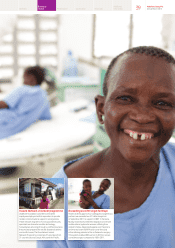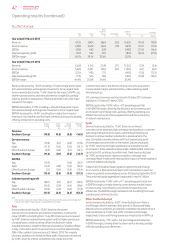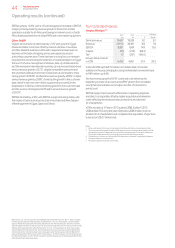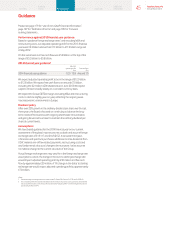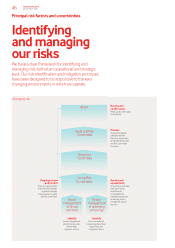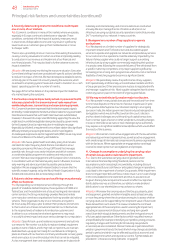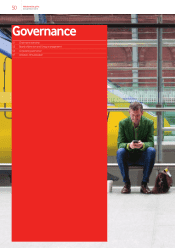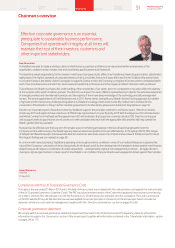Vodafone 2013 Annual Report Download - page 49
Download and view the complete annual report
Please find page 49 of the 2013 Vodafone annual report below. You can navigate through the pages in the report by either clicking on the pages listed below, or by using the keyword search tool below to find specific information within the annual report.
Overview Business
review Performance Governance Financials Additional
information
The Group’s key risks are outlined below:
1. Our business could be adversely affected by a failure
or signicant interruption to our telecommunications
networks or IT systems.
Risk: We are dependent on the continued operation of
telecommunications networks. As the importance of mobile and xed
communication in everyday life increases, as well as during times
of crisis, organisations and individuals look to us to maintain service.
Major failures in the network or our IT systems may result in service
being interrupted resulting in serious damage to our reputation and
consequential customer and revenue loss.
There is a risk that an attack on our infrastructure by a malicious
individual or group could be successful and impact the availability
of critical systems. Our network is also susceptible to interruption due
to a physical attack and theft of our network components as the value
and market for network components increases (for example copper,
batteries, generators and fuel).
Mitigation: Specic back-up and resilience requirements are built into
our networks. We monitor our ability to replace strategic equipment
quickly in event of failure, and for high risk components, we maintain
dedicated back-up equipment ready for use. Dedicated network
equipment is installed on trucks ready to be moved on site if required.
Our critical infrastructure has been enhanced to prevent unauthorised
access and reduce the likelihood and impact of a successful attack.
Network contingency plans are linked with our business continuity and
disaster recovery plans which are in place to cover the residual risks
that cannot be mitigated. A crisis management team and escalation
processes are in place both nationally and internationally, and crisis
simulations are conducted annually.
We also manage the risk of malicious attacks on our infrastructure using
our global security operations centre that provides 24/7 monitoring
of our network in many countries.
2. We could suffer loss of consumer condence and/or legal
action due to a failure to protect our customer information.
Risk: Mobile networks carry and store large volumes of condential
personal and business voice trafc and data. We host increasing
quantities and types of customer data in both enterprise and consumer
segments. We need to ensure our service environments are sufciently
secure to protect us from loss or corruption of customer information.
Failure to protect adequately customer information could have
a material adverse effect on our reputation and may lead to legal action
against the Group.
Mitigation: Both the hardware and software applications which hold
or transmit condential personal and business voice and data trafc
include security features. Security related reviews are conducted
according to our policies and security standards. Security governance
and compliance is managed and monitored through software tools
that are deployed to all local markets and selected partner markets.
Our data centres are managed to international information security
standards. Third party data security reviews are conducted jointly with
our technology security and corporate security functions.
3. Increased competition may reduce our market share
and protability.
Risk: We face intensifying competition where all operators are looking
to secure a share of the potential customer base. Competition could lead
to a reduction in the rate at which we add new customers, a decrease
in the size of our market share and a decline in our average revenue per
customer, if customers choose to receive telecommunications services
or other competing services from alternate providers. Competition can
also lead to an increase in customer acquisition and retention costs.
The focus of competition in many of our markets has shifted from
acquiring new customers to retaining existing customers, as the market
for mobile telecommunications has become increasingly mature.
Mitigation: We will continue to promote our differentiated propositions
by focusing on our points of strength such as network quality, capacity
and coverage, quality of customer service and the value of our products
and services. We are enhancing distribution channels to get closer
to customers and using targeted promotions where appropriate
to attract and retain specic customers. We closely monitor and
model competitor behaviour, network builds and product offerings
to understand future intentions to be able to react in a timely manner.
4. Regulatory decisions and changes in the regulatory
environment could adversely affect our business.
Risk: We have ventures in both emerging and mature markets, spanning
a broad geographical area including Europe, Africa, Middle East, Asia Pacific
and the US. We need to comply with an extensive range of requirements
that regulate and supervise the licensing, construction and operation
of our telecommunications networks and services. Pressure on political
and regulatory institutions both to deliver direct consumer benefit
and protect consumers’ interests, particularly in recessionary periods,
can leadto adverse impacts on our business. Financial pressures
on smallercompetitors can drive them to call for regulators to protect
them. Increased financial pressures on governments may lead them
to target foreign investors for further taxes or licence fees.
Mitigation: We monitor political developments in our existing and
potential markets closely, identifying risks in our current and proposed
commercial propositions. Regular reports are made to our Executive
Committee on current political and regulatory risks. These risks are
considered in our business planning process, including the importance
of competitive commercial pricing and appropriate product strategies.
Authoritative and timely intervention is made at both national and
international level in respect of legislative, scal and regulatory
proposals which we feel are not in the interests of the Group. We have
regular dialogue with trade groups that represent network operators
and other industry bodies to understand underlying political pressures.
5. Our existing service offerings could become disadvantaged
as compared to those offered by converged competitors
or other technology providers.
Risk: In a number of markets we face competition from providers who
have the ability to sell converged services (combinations of xed line,
broadband, public Wi-Fi, TV and mobile) on their existing infrastructure
which we cannot either replicate or provide at a similar price point.
Additionally, the combination of services may allow competitors
to subsidise the mobile component of their offering. This could lead
to an erosion of our customer base and reduce the demand for our core
services and impact our future protability.
Advances in smartphone technology places more focus on applications,
operating systems, and devices rather than the underlying services
provided by mobile operators. The development of applications
which make use of the internet as a substitute for some of our more
traditional services, such as messaging and voice, could erode revenue.
Reduced demand for our core services of voice, messaging and data
and the development of services by application developers, operating
system providers, and handset suppliers could signicantly impact our
future protability.
Mitigation: In some markets we are already providing xed-line
telecommunication services (voice and broadband). In other existing
markets we actively look for opportunities to provide services beyond
mobile through acquisition, partnerships, or joint ventures.
We have also developed strategies which strengthen our relationships
with customers by accelerating the introduction of integrated voice,
messaging and data tariffs to avoid customers reducing their out-of-
bundle usage through substitution.
47 Vodafone Group Plc
Annual Report 2013




